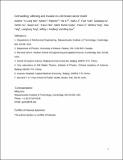Cell swelling, softening and invasion in a three-dimensional breast cancer model
Author(s)
Han, Yulong; Pegoraro, Adrian F.; Li, Hui; Li, Kaifu; Yuan, Yuan; Xu, Guoqiang; Gu, Zichen; Sun, Jiawei; Hao, Yukun; Gupta, Satish Kumar; Li, Yiwei; Tang, Wenhui; Kang, Hua; Teng, Lianghong; Fredberg, Jeffrey J.; Guo, Ming; ... Show more Show less
DownloadAccepted version (1.225Mb)
Publisher Policy
Publisher Policy
Article is made available in accordance with the publisher's policy and may be subject to US copyright law. Please refer to the publisher's site for terms of use.
Terms of use
Metadata
Show full item recordAbstract
Control of the structure and function of three-dimensional multicellular tissues depends critically on the spatial and temporal coordination of cellular physical properties, yet the organizational principles that govern these events and their disruption in disease remain poorly understood. Using a multicellular mammary cancer organoid model, we map here the spatial and temporal evolution of positions, motions and physical characteristics of individual cells in three dimensions. Compared with cells in the organoid core, cells at the organoid periphery and the invasive front are found to be systematically softer, larger and more dynamic. These mechanical changes are shown to arise from supracellular fluid flow through gap junctions, the suppression of which delays the transition to an invasive phenotype. These findings highlight the role of spatiotemporal coordination of cellular physical properties in tissue organization and disease progression.
Date issued
2019-10Department
Massachusetts Institute of Technology. Department of Mechanical EngineeringJournal
Nature Physics
Publisher
Springer
Citation
Han, Yu Long et al. "Cell swelling, softening and invasion in a three-dimensional breast cancer model." Nature Physics 16, 1 (October 2019): 101–108 © 2019 The Author(s)
Version: Author's final manuscript
ISSN
1745-2473
1745-2481